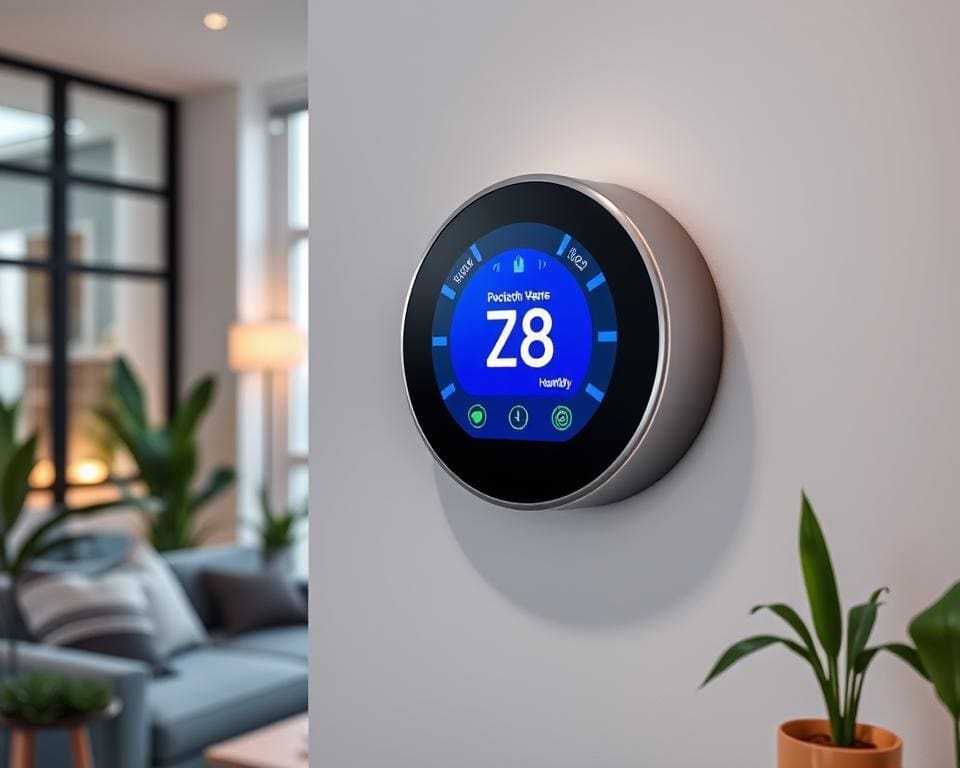In the realm of modern home climate management, smart thermostats with humidity controls stand out as remarkable advancements, blending technology with convenience to elevate the indoor living experience. These innovative devices not only allow for precise digital temperature control, but they also monitor and adjust humidity levels, ensuring a harmonious environment year-round. With a strong focus on energy efficiency, these programmable thermostats learn your preferences and adapt accordingly, significantly optimising energy consumption without sacrificing comfort.
As homeowners increasingly recognise the significance of a balanced indoor climate, investing in smart thermostats has become essential. Leading brands like Nest, Ecobee, and Honeywell offer unique features tailored to varied consumer needs, making it easier than ever to achieve the ultimate home comfort suited to today’s lifestyles. Explore more about these essential gadgets for tech enthusiasts by visiting this guide.
Understanding Smart Thermostats
In today’s rapidly evolving technological landscape, a smart thermostat represents a significant advancement in home climate control. With the integration of smart home technology, these devices not only regulate temperature but also enhance energy efficiency, making them a pivotal element for modern households.
What is a Smart Thermostat?
A smart thermostat is an innovative device designed to control heating and cooling systems from anywhere using a smartphone or voice command. Unlike traditional thermostats, they connect directly to Wi-Fi, providing users with remote access and programmable features that lead to optimal energy efficient heating. This level of control helps families maintain a comfortable home environment while effectively managing their energy usage.
Key Features of Smart Technology
Smart thermostats boast several notable features that distinguish them from conventional models:
- Learning Algorithms: These allow the thermostat to adapt to the homeowner’s routine, predicting temperature adjustments for maximum comfort.
- Wi-Fi Connectivity: Offers remote control, enabling users to monitor and adjust their home’s heating and cooling systems from their devices.
- Geofencing: This feature modifies settings based on the user’s location, preventing energy waste when the home is vacant.
- Integration with Other Devices: Smart thermostats can work harmoniously with air purifiers and smart vents, creating a comprehensive home climate control system.

Benefits of Humidity Control
Maintaining optimal humidity levels is essential for creating a comfortable home environment. Humidity greatly influences how warm or cool a space feels, which directly impacts overall home comfort. Smart thermostats with humidity controls play a crucial role in regulating these levels, ensuring a pleasant atmosphere for occupants.
Why is Humidity Important for Home Comfort?
Humidity levels between 30-50% enhance the comfort of living spaces. High humidity can lead to an oppressive sensation, making it difficult for the body to cool itself through sweat evaporation. On the other hand, low humidity often results in dry skin and respiratory discomfort. Utilising smart thermostats with humidity controls can help manage these levels effectively, promoting a healthier indoor air quality and enhancing the overall comfort of your home.
Effects of Poor Humidity Management
Poor humidity management can lead to significant health issues and structural problems within a home. Excess moisture can promote mould growth, posing health risks particularly for individuals with respiratory conditions. Low humidity, conversely, can generate dry air that results in discomfort, skin irritation, and respiratory issues. Such mismanagement not only affects personal well-being but can increase energy costs as HVAC systems struggle to maintain an even temperature. Understanding the importance of humidity is vital for establishing an environment that is both comfortable and conducive to good health. For further insights on optimising energy use in your home, refer to energy-saving heating systems that can help manage temperature and humidity effectively. Read more here.
Smart Thermostats with Humidity Controls
As smart home technology continues to evolve, smart thermostats with humidity controls have emerged as essential tools for optimizing home environments. These innovative devices not only manage temperature but also monitor and adjust humidity levels, ensuring maximum comfort. Several top models on the market showcase unique features that cater to various user preferences.
Top Models in the Market
The selection of smart thermostats is impressive, with leading brands offering products equipped with advanced functionality. Notable choices include:
- Nest Learning Thermostat: This model features an intelligent learning capability, adapting to user habits and automatically regulating humidity levels for perfect home comfort.
- Ecobee SmartThermostat with Voice Control: Incorporating integrated Alexa functionality, this thermostat utilises room sensors to effectively monitor temperature and humidity in multiple spaces.
- Honeywell Home T9 Smart Thermostat: This offering allows customisation through its remote sensors, letting users fine-tune climate settings based on specific areas in their homes.
Features to Look for in Humidity Control
When evaluating smart thermostats with humidity controls, certain features enhance their effectiveness:
- Humidity sensors provide real-time data, enabling users to swiftly adjust levels as needed.
- Wi-Fi connectivity allows for remote control through smartphones, promoting convenience and ease of use.
- User-friendly apps facilitate programmable schedules, making it simple to customize settings.
- Wireless thermostat options offer flexibility in placement, accommodating diverse home layouts and enhancing installation ease.
How Programmable Thermostats Enhance Energy Efficiency
Programmable thermostats play a pivotal role in improving energy efficiency within modern homes. These devices allow users to tailor their heating and cooling schedules to match their daily routines effectively. By setting specific temperature goals at different times of the day, users can ensure that energy consumption remains minimal when spaces are unoccupied.
Scheduling Your Heating and Cooling
The ability to programme heating and cooling systems leads to significant savings. For instance, energy-efficient heating can be programmed to lower temperatures during the night and automatically resume comfort levels before waking. This targeted approach not only reduces energy waste but also ensures a comfortable environment when needed. Many smart thermostats also utilise adaptive technology, dynamically adjusting schedules based on usage patterns.
Benefits of Energy Efficient Heating
A programmable thermostat contributes to the broader goals of environmental sustainability. Implementing energy-efficient heating reduces the overall energy footprint, which, in turn, alleviates the strain on natural resources. These savings reflect not just in monthly bills but also in longer-term benefits, such as enhanced durability of heating systems, leading to fewer maintenance demands. For individuals seeking branded solutions for a balanced approach to climate control, further information can be explored here.
Enhancing Home Climate Control
Integrating smart thermostats with other smart home devices can significantly enhance home climate control. This synergy not only boosts performance but also helps manage humidity control effectively, ensuring an enjoyable indoor environment. From humidifiers and dehumidifiers to air purifiers and smart lights, a network of these devices works collectively to create an optimal climate.
Integration with Other Smart Home Devices
When the thermostat detects high humidity levels, it can automatically activate a connected dehumidifier, maintaining moisture levels without manual intervention. This holistic approach maximises comfort and reduces energy consumption, demonstrating the true potential of modern smart home devices. Homeowners can stay informed about the conditions in their living spaces through smartphone notifications, receiving updates on air quality and climate status.
Using Sensors for Optimal Performance
Sensors are vital in the operation of smart thermostats, providing real-time data for precise adjustments. Many advanced models include built-in temperature and humidity sensors that continuously monitor the environment. This information allows smart thermostats to maintain ideal conditions, adapting to changes instantaneously. Some devices support remote sensors, enabling a balanced climate throughout the home, effectively addressing cold spots and overheating in various rooms.
Improving Indoor Air Quality
Indoor air quality is a crucial aspect of home comfort and health. Humidity plays a significant role in determining the quality of air we breathe inside our homes. Both high and low humidity levels can lead to various health issues, making effective humidity management essential for maintaining a pleasant atmosphere.
How Humidity Affects Indoor Air Quality
When humidity levels are too high, the environment becomes a breeding ground for allergens such as mould and dust mites. Exposure to these allergens can aggravate respiratory conditions and lead to discomfort. Low humidity, conversely, can produce dry air, which irritates mucous membranes and contributes to health problems. Smart thermostats with integrated humidity controls offer a practical solution, allowing precise regulation of humidity levels to promote healthier indoor air quality.
Selecting the Right Indoor Air Quality Monitor
Choosing an appropriate indoor air quality monitor is paramount for effective humidity control. Look for features including real-time data reporting, alerts for fluctuations in humidity levels, and seamless integration with smart home systems. Brands like Eve Room and Netatmo exemplify options that offer these functionalities. With the right indoor air quality monitor, homeowners can stay informed about their environment, making proactive adjustments to ensure optimal air quality. For inspiration on enhancing your living space’s aesthetic alongside air quality, explore interior design trends that incorporate natural elements.
Wireless Thermostats and Their Advantages
In the realm of smart home technology, wireless thermostats stand out for their remarkable flexibility and convenience, revolutionising how homeowners manage their indoor climate. By eliminating the complications of wiring, these devices can be effortlessly installed in various locations, allowing users to tailor settings to their unique preferences.
Flexibility and Convenience
One of the most appealing aspects of a wireless thermostat is the ability to monitor and control heating and cooling systems remotely. Utilising smartphone apps, users can make adjustments from virtually anywhere, ensuring a comfortable environment upon return without incurring unnecessary energy costs. This adaptiveness not only contributes to a more efficient energy management system but also enhances overall comfort within the home.
Understanding Wireless Connectivity Options
Grasping wireless connectivity options is essential when selecting the right smart thermostat for your home. Most models function via Wi-Fi, enabling seamless access through dedicated mobile applications. Alternatively, some devices use technologies such as Z-Wave or Zigbee, which provide a solid connection through a central home hub, increasing reliability and range. When investing in a smart thermostat, individuals should evaluate their existing smart home ecosystem to guarantee smooth integration and maximise functionality.
Digital Temperature Control: A Necessity for Modern Living
In today’s fast-paced world, digital temperature control has emerged as a fundamental aspect of modern living. The increasing demand for energy-efficient and comfortable homes has made smart thermostats with humidity controls an essential addition. These devices allow homeowners to monitor and adjust both temperature and humidity levels seamlessly, creating an optimal environment that promotes home comfort.
The advantages of integrating smart technology into home climate systems cannot be overstated. By implementing digital temperature control solutions, households can achieve a balanced atmosphere that not only enhances daily comfort but also fosters sustainability. With the capability to respond to changing conditions, smart thermostats with humidity controls empower users to take charge of their living spaces in a way that is both practical and environmentally conscious.
As comfort and sustainability continue to take precedence in our lives, the adoption of advanced temperature management systems is no longer a luxury but a necessity. Embracing these innovations not only elevates one’s quality of life but also signifies a commitment to energy efficiency and environmental stewardship, making digital temperature control a cornerstone of contemporary living.









